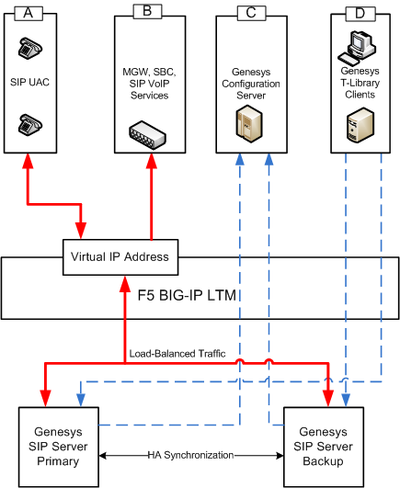Overview
The SIP Server and BIG-IP LTM integration solution described in this topic enables you to preserve SIP sessions between SIP Server and other SIP-enabled devices that are involved in contact center operations, in switchover scenarios.
In this integration solution, one Virtual Server configured on the BIG-IP LTM is associated with a single IP address (referred to as Virtual IP address), and it represents one HA pair of SIP Servers configured as members of one server pool that is associated with the Virtual Server. It is possible to have more than one HA pair running behind a single BIG-IP LTM. This requires configuring additional Virtual Servers and server pools for each HA pair in the way that the one unique Virtual IP address is used for each HA pair.
Integration Solution Notes
- Up-front load balancing via Network SIP Server or other device could be implemented, but is not described in this topic.
- BIG-IP LTM supports an active/hot-standby HA mode itself; configuration of the LTM in HA mode is not described in this topic and has not been validated with SIP Server.
- Either UDP or TCP can be used as the transport for SIP signaling. Use of TLS for encrypted SIP signaling has not been validated, and configuration of TLS is not described in this topic.
- BIG-IP LTM can be configured in a more complex load-balancing role. This is beyond the scope of this topic.
Deployment Architecture
The following figure depicts a sample deployment architecture of primary and backup SIP Servers with the BIG-IP LTM, in which:
- BIG-IP LTM is positioned as a network router between a SIP Server HA pair and other network entities.
- Hosts where SIP Servers are running use the BIG-IP LTM as the default gateway.
- BIG-IP LTM is configured to apply SNAT (Secure Network Address Translation) to all outbound packets, with the exception of destinations that are defined in the SNAT exclusion group.
Deployment Requirements
There are four different communication groups of devices that interact with SIP Server (see the preceding figure). Each group has its own requirements that must be considered when configuring the BIG-IP LTM.
SIP Phones Group
The SIP Phones group (group A in the preceding figure) includes SIP phones that are used by agents.
Initially, devices of this group use the REGISTER method to notify SIP Server of the current Contact URI (IP address). SIP Server uses the Contact information for further communication with the device.
By default, SIP Server uses the UDP to communicate with devices of the group. Devices send requests to and receive responses from the BIG-IP LTM Virtual IP address.
This group requires that:
- Any inbound packets received at the BIG-IP LTM Virtual IP address are directed to the primary SIP Server.
- SNAT is applied to any outbound packets that are sent to devices of the group, which means that a source IP address of the outbound packet is translated from a SIP Server physical IP address to the BIG-IP LTM Virtual IP address.
SIP Service Devices Group
The SIP Service Devices group (group B in the preceding figure) includes media gateways, softswitches, Session Border Controllers (SBC), and SIP-based VoIP Service devices such as Genesys Stream Manager. These devices do not register with SIP Server; their contact information is known in advance and it remains consistent.
By default, SIP Server uses the UDP to communicate with devices of the group. Devices receive requests from the BIG-IP LTM Virtual IP address.
This group requires that:
- Any inbound packets received at the BIG-IP LTM Virtual IP address are directed to the primary SIP Server.
- SNAT is applied to any outbound packets that are sent to devices of the group.
Genesys Configuration Server
SIP Server maintains permanent TCP/IP connection with Genesys Configuration Server (group C in the preceding figure). Requests to Configuration Server are sent from a SIP Server physical IP address. Responses from Configuration Server are directed to the SIP Server physical IP address.
This group requires that:
- No SNAT is applied to outbound packets sent to Configuration Server.
- The primary or backup SIP Server is accessible via its physical IP address.
Genesys T-Library Clients Group
All Genesys T-Library clients (group D in the preceding figure) that implement Genesys T-Library functionality maintain permanent TCP/IP connection with SIP Server. Devices send requests to and receive responses from a SIP Server (primary or backup) physical IP address.
This group requires that:
- No SNAT is applied to outbound packets sent to devices of the group.
- The primary or backup SIP Server is accessible via its physical IP address.
Note: In this deployment architecture, the HA synchronization traffic between primary and backup SIP Servers does not pass through the BIG-IP LTM, that is why it is excluded from applying SNAT.

